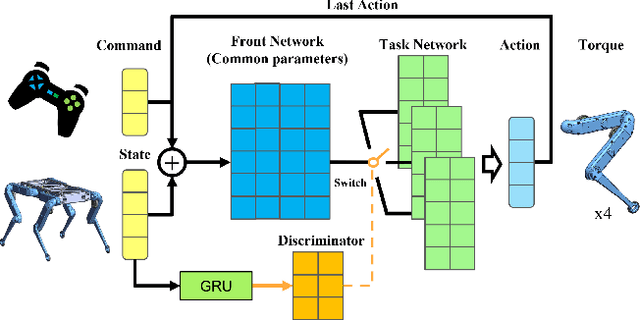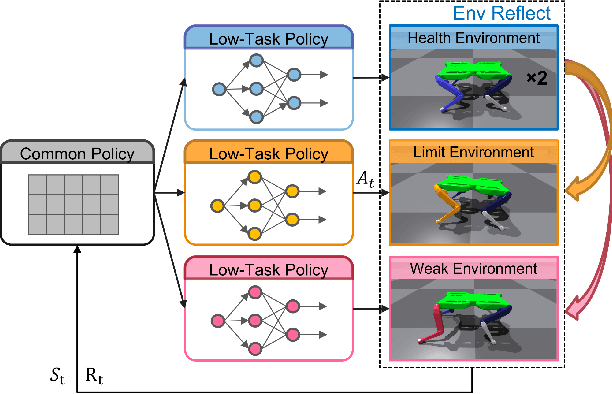Jiaxin Tu
Continuous Control of Diverse Skills in Quadruped Robots Without Complete Expert Datasets
Mar 05, 2025Abstract:Learning diverse skills for quadruped robots presents significant challenges, such as mastering complex transitions between different skills and handling tasks of varying difficulty. Existing imitation learning methods, while successful, rely on expensive datasets to reproduce expert behaviors. Inspired by introspective learning, we propose Progressive Adversarial Self-Imitation Skill Transition (PASIST), a novel method that eliminates the need for complete expert datasets. PASIST autonomously explores and selects high-quality trajectories based on predefined target poses instead of demonstrations, leveraging the Generative Adversarial Self-Imitation Learning (GASIL) framework. To further enhance learning, We develop a skill selection module to mitigate mode collapse by balancing the weights of skills with varying levels of difficulty. Through these methods, PASIST is able to reproduce skills corresponding to the target pose while achieving smooth and natural transitions between them. Evaluations on both simulation platforms and the Solo 8 robot confirm the effectiveness of PASIST, offering an efficient alternative to expert-driven learning.
A Robust Quadruped Robot with Twisting Waist for Flexible Motions
Oct 08, 2024



Abstract:The waist plays a crucial role in the agile movement of many animals in nature. It provides the torso with additional degrees of freedom and flexibility, inspiring researchers to incorporate this biological feature into robotic structures to enhance robot locomotion. This paper presents a cost-effective and low-complexity waist mechanism integrated into the structure of the open-source robot solo8, adding a new degree of freedom (DOF) to its torso. We refer to this novel robot as solo9. Additionally, we propose a full-body control method for the waist-equipped quadruped robot based on generative adversarial imitation learning (GAIL). During training, the discriminator is used as input for iterative optimization of the policy and dataset, enabling solo9 to achieve flexible steering maneuvers across various gaits. Extensive tests of solo9's steering capabilities, terrain adaptability, and robustness are conducted in both simulation and real-world scenarios, with detailed comparisons to solo8 and solo12, demonstrating the effectiveness of the control algorithm and the advantages of the waist mechanism.
Multi-Task Learning of Active Fault-Tolerant Controller for Leg Failures in Quadruped robots
Feb 14, 2024



Abstract:Electric quadruped robots used in outdoor exploration are susceptible to leg-related electrical or mechanical failures. Unexpected joint power loss and joint locking can immediately pose a falling threat. Typically, controllers lack the capability to actively sense the condition of their own joints and take proactive actions. Maintaining the original motion patterns could lead to disastrous consequences, as the controller may produce irrational output within a short period of time, further creating the risk of serious physical injuries. This paper presents a hierarchical fault-tolerant control scheme employing a multi-task training architecture capable of actively perceiving and overcoming two types of leg joint faults. The architecture simultaneously trains three joint task policies for health, power loss, and locking scenarios in parallel, introducing a symmetric reflection initialization technique to ensure rapid and stable gait skill transformations. Experiments demonstrate that the control scheme is robust in unexpected scenarios where a single leg experiences concurrent joint faults in two joints. Furthermore, the policy retains the robot's planar mobility, enabling rough velocity tracking. Finally, zero-shot Sim2Real transfer is achieved on the real-world SOLO8 robot, countering both electrical and mechanical failures.
 Add to Chrome
Add to Chrome Add to Firefox
Add to Firefox Add to Edge
Add to Edge